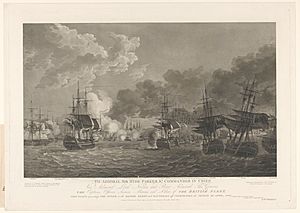HMS Russell (1764) facts for kids

Russell
|
|
Quick facts for kids History |
|
|---|---|
| Name | HMS Russell |
| Ordered | 8 January 1761 |
| Builder | West, Deptford |
| Launched | 10 November 1764 |
| Honours and awards |
Participated in: |
| Fate | Sold out of the service, 1811 |
| Notes | Harbour service from 1812 |
| General characteristics | |
| Class and type | Ramillies-class ship of the line |
| Tons burthen | 1642 bm |
| Length | 168 ft 6 in (51.36 m) (gundeck) |
| Beam | 46 ft 11 in (14.30 m) |
| Depth of hold | 19 ft 9 in (6.02 m) |
| Propulsion | Sails |
| Sail plan | Full-rigged ship |
| Armament |
|
HMS Russell was a powerful warship of the Royal Navy, the navy of Great Britain. She was a "74-gun ship of the line", meaning she carried 74 cannons and was designed to fight in the main battle line of a fleet. Russell was built at Deptford and launched on November 10, 1764. She served for many years, taking part in several important naval battles.
Russell in Action: Famous Battles
Russell had a long and active career, participating in major conflicts. She was known for her strength and the skill of her crews.
Battle of the Saintes (1782)
In 1782, Captain James Saumarez commanded Russell. She fought in the Battle of the Saintes in the Caribbean Sea. This was a big naval battle between the British and French fleets. The British won, which was a very important victory.
The Glorious First of June (1794)
Years later, in 1794, Russell was part of Admiral Howe's fleet. They fought in a huge battle known as the Glorious First of June. This battle took place in the Atlantic Ocean during the French Revolutionary Wars. It was a major clash where the British Navy defeated the French fleet.
Battle of Groix (1795)
The very next year, in 1795, Russell was again in action at the Battle of Groix. This battle happened off the coast of France. The British fleet chased and captured several French ships.
Battle of Camperdown (1797)
In 1797, Captain Henry Trollope was in charge of Russell. She played a role in the Battle of Camperdown, fought off the coast of the Netherlands. This battle was another important British victory against the Dutch fleet.
Adventures at Sea
Russell also had other adventures. In 1801, she helped a merchant ship called Duckingfield Hall that had been badly damaged in a storm. Russell towed the damaged ship to safety.
Battle of Copenhagen (1801)
In March 1801, Russell joined a British fleet heading to the Baltic Sea. Their mission was to challenge a group of countries called the Second League of Armed Neutrality. During this time, a storm hit, and Russell helped save another British ship, HMS Tickler, from being captured by the Swedes.
On April 2, 1801, Russell fought in the Battle of Copenhagen. Even though she ran aground early in the fight, her crew managed to fire at the Danish ship Prøvesteenen. When the Danish ship surrendered, Russell sent boats to take control of it. Years later, the sailors who fought in this battle received a special medal.
Capturing a French Brig (1803)
In 1803, Russell was on patrol when she encountered a 14-gun French navy brig. Russell successfully attacked and destroyed the French ship.
Escorting Merchant Ships (1803)
Later in 1803, Russell was part of a group of warships escorting several East Indiamen. These were large merchant ships belonging to the British East India Company. They were carrying valuable goods and money to Bengal, India, and needed protection from enemy ships.
Taking Tranquebar (1808)
In 1808, Russell sailed to Tranquebar, a Danish area in India. She landed British soldiers there. The town surrendered without a fight, and Russell helped secure this important location.
The End of Russell's Service
After many years of active duty and important battles, HMS Russell was sold out of the Royal Navy in 1811. She had served Great Britain well during a time of great naval conflicts.


